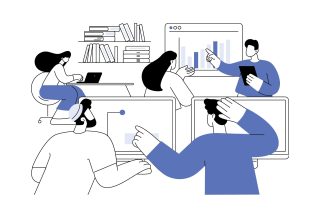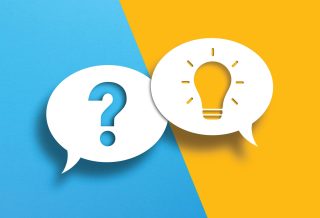IDEAS
Coaching — anytime, from anywhere — empowers teachers
By Gina Fugnitto and Kelly Stuart
Categories: Coaching, TechnologyAugust 2021
Teaching children to read fluently is one of the major goals in early elementary classrooms, and it requires teachers to have knowledge and skills about literacy development.
In the past few years, literacy experts have been calling for more attention to the research underpinning the science of reading. This evidence base has clarified that a combination of attending to systematic, explicit instruction in phonics and deep reading comprehension work is the most effective approach to teaching students from all socioeconomic backgrounds to read (Defining Movement, 2021).
However, teachers don’t learn the skills or get support to use these practices. Only 51% of teacher preparation courses teach scientifically based reading instructional practices (Drake & Walsh, 2020), and professional learning is inconsistent. Although school districts spend over a billion dollars a year on literacy materials that promise to improve instruction (AAP, 2021), those efforts do not achieve substantial positive impacts on teacher performance and student outcomes (Short & Hirsh, 2020).
''Only 51% of teacher preparation courses teach scientifically based reading instructional practices.'' #TheLearningPro Share on XIn our experience, teacher professional learning is often disjointed and not aligned with the new curricula teachers use in daily instruction. This lack of preparation has led to fragmented approaches to teaching young students to read, in part because initiatives lose momentum, teachers modify the instruction beyond recognition, and programs are soon eclipsed by newer curricula that face the same structural limitations. Schools have a long way to go in scaling effective reading instruction.
Collaborative Classroom is a mission-driven nonprofit organization working to close that distance. It is our goal to provide teachers with high-quality curricula that authentically integrate social and emotional learning into literacy instruction in a way that strengthens teacher practice and improves student learning.
We intentionally design our curriculum materials to be educative; that is, teachers learn new skills and content as they teach student-facing lessons (Sawyer, n.d.; Ball & Cohen, 1996). But in recent years, especially during remote learning due to COVID-19, we have recognized that teachers need more intensive and personalized support, and we have been exploring ways to extend that support through coaching.
Our colleagues at Javelin Learning introduced us to their asynchronous coaching approach in the health care field, and we saw its potential for providing coaching to teachers at scale — an ongoing challenge for the education field.
In partnership, our organizations developed Collaborative Coach, personalized coaching support for teachers to be paired with our evidence-based curriculum. This combination has the potential to transform the way teachers support students.
WHAT IS COLLABORATIVE COACH?
Collaborative Coach is a personalized, video-based asynchronous coaching approach using a web-based coaching tool. It pairs each teacher with an instructional coach who provides curriculum-specific support.
Without geographical or scheduling limitations, asynchronous coaching provides flexibility for teacher engagement and allows us to more effectively scale our efforts to provide curriculum-based coaching.
We piloted this new model with teachers implementing Collaborative Classroom’s foundational literacy skills program Systematic Instruction in Phonological Awareness, Phonics, and Sight Words and are now extending its use to more of our instructional programs.
Collaborative Coach includes the following steps (see diagram in pdf).
Pre-coaching questionnaire: The teacher completes a curriculum-focused questionnaire that identifies a problem of practice. In the initial part of the questionnaire, the teacher answers a few general questions about curriculum implementation. Next, the teacher reflects on his or her practice using a curriculum-focused elements of implementation tool. Finally, the teacher selects a coaching focus from a list of common problems of practice.
Identify area of focus: The coach reviews the questionnaire and provides a short, targeted learning activity via the coaching tool that might include opportunities to delve into program materials, read curriculum-specific blogs, rehearse instructional routines, or analyze progress monitoring data.
Learning activity: The teacher engages in the learning activity and creates and uploads a brief video demonstrating his or her learning to the coaching tool. The video might include reflections from the learning activity or demonstrate an instructional routine.
Feedback and coaching: The coach reviews the video via the coaching tool and records personalized feedback and additional coaching tips.
Reflect, refine, and identify next steps for learning: These efficient, asynchronous steps can be repeated or adjusted to support specific teachers.
WHAT WE LEARNED
Twenty-seven teachers applied to be a part of the Collaborative Coach pilot. Of those teachers, 17 completed the seven-week pilot. Though excited to engage in coaching, the teachers who did not complete it cited reasons such as a change in teaching format (virtual, in-person, hybrid) or medical issues. The pilot teachers included 11 interventionists, two reading coaches, a district resource teacher, a classroom teacher, a reading specialist, and a special education teacher.
The asynchronous experience allowed teachers to participate from across the country: four from Florida, two from West Virginia, two from Illinois, two from Virginia, and the remaining teachers from California, Montana, Minnesota, New York, South Carolina, and Texas. A Collaborative Coach in Florida coached the teachers throughout the pilot experience.
All pilot teachers shared their insights by completing a post-pilot survey. Additionally, four pilot teachers provided additional insights into Collaborative Coach by engaging in an in-depth post-survey interview. Here we share findings from these sources, using teachers’ first names only to protect confidentiality.
The pilot went smoothly, and teachers and coaches reported benefits from participating. Coaches provided timely, personalized feedback. Teachers appreciated the flexibility of using the coaching on their own schedule and engaging in just-in-time learning. For example, Robin, a Tier 2 interventionist in Seminole County, Florida, reported that she was able to improve her practice with a manageable time investment, and Kendra, a reading specialist from Salem City Schools in Virginia, said that the swift response from her coach made it feel like the coach was right beside her at all times.
We gained insights into the practices that best support curriculum-based coaching and teacher learning in a video-based, asynchronous setting. Because of the asynchronous approach, the coach had to actively listen to the reflections of the teacher without interrupting. As a result, the teachers directed their learning and made visible the new learnings, wonderings, and struggles.
This was different from many typical coaching conversations, in which the coach might interrupt, interject, or unintentionally manipulate the conversation. As Marcie, a classroom teacher from Horry County, South Carolina, said, “This type of coaching was unique because it was not conversation-based; rather, I had to navigate my own learning in the reflections, and the coach has to respond to that learning.” She said the feedback felt very personal and encouraged her to think deeply about her own teaching.
The opportunity to create reflection videos pushed teachers to reflect on their own practice, resulting in more self-awareness and internalizing new learning. Kendra, the reading specialist from Virginia, said, “I think the value of recording yourself and framing growth and reflection around personal noticings is the best professional development in which a professional can engage. I can hear my own voice and my coach’s voice from my reflection video each day I work with my groups.”
The focus on curriculum-based learning spurred teachers to deepen their practice. The coach promotes active learning by directly linking content knowledge to classroom practice (Sawyer & Stukey, 2019). For Katie, a reading coach in Seminole County, Florida, Collaborative Coach was an efficient way to improve a very specific element of her practice: understanding how to more effectively support students with polysyllabic decoding when encountering a schwa. It also deepened her knowledge of how the science of reading is embedded in the curriculum.
For Joy, a special education teacher in Chicago, Illinois, the Collaborative Coach experience exposed aspects of the curriculum and instructional questions that had not yet been discovered: “At first, I did not know what I wanted to know more about. The feedback and guidance were motivating for me. The more feedback I received, the more I dug into the program materials, the more I was able to generate questions and identify things that I wanted to learn more about. The very specific feedback from the coach offered me things that I could chew on and help me think about my instruction and the student experience.”
BUILD YOUR OWN PROGRAM
Whether you’re a district or school-based leader or coach, you can take these ideas into your own curriculum-based professional learning and tailor them to your educators’ needs. As Jim Short and Stephanie Hirsh pointed out in a recent report, “Curriculum-based professional learning experiences are most successful when they are designed to move teachers through different stages of learning. Like their students, teachers engage in sense-making, though that plays out differently because teachers have different experiences and needs” (Short & Hirsh, 2020). Here are some steps to take and questions to think about as you apply the lessons from our Collaborative Coach pilot.
Identify the technology. Consider what technology tools you have available that might best support coaching in an asynchronous format.
- What tool might you use to generate a questionnaire? We initially used a GoogleForm and then transitioned to JotForm.
- What tool might you use to share the learning activity? We initially used GoogleDoc shared via a Google SharedFolder.
- What tool might you use to generate the video reflections and coaching feedback? We initially used Zoom as a tool for recording and shared videos via a Google SharedFolder.
Determine a focus for learning. Consider your educators’ most pressing needs and craft questions that will drive reflection and learning.
- We initially focused on a single program to focus and refine our work.
- We developed a questionnaire to determine educators’ specific needs, support teachers’ reflection, and provide initial data for the coaches.
Create learning activities. Based on the questionnaire, generate learning activities that cause teachers to reflect on practice and students’ response to instruction, practice instructional moves, or otherwise support teaching and learning.
Plan for engaging in the cycle of learning. Determine when, how, and with whom you will engage in the cycle of learning.
- Who might engage in the cycle of learning? We initially sought teachers from our implementing districts who were interested in professional growth around phonics instruction.
- What will your timeline be? We initially engaged in a two-week cycle, but learned that that felt rushed. We are extending the cycle to eight weeks.
- What is your anticipated workflow for engaging? We initially provided feedback within 24 to 48 hours. Teachers confirmed that they preferred immediate feedback (48 to 72 hours).
- How will you adjust to meet teachers’ needs? We realized that the asynchronous steps needed to be adjusted for different situations.
IMPROVING TEACHER PRACTICE
Although Collaborative Coach is a recent development, we are already seeing high levels of satisfaction and learning among participants in our pilot. For example, Kelly, an interventionist in Bethalto School District #8 in Illinois, said, “This is the most powerful professional learning I have participated in throughout my career. This process allowed me to reflect on my own practice and have individual coaching feedback.”
Kimberly, a district resource teacher in Hillsborough County, Florida, told us, “My collaborative coach was a valuable asset to me. This process allowed me to self-reflect, redirect, and refine my teaching techniques based on her recommendations. … Overall, this gave me a designated time to examine my [reading curriculum] materials and appreciate the depth of knowledge included within the program.”
As we strive to better support implementations of Collaborative Classroom curriculum programs, improving teacher practice is at the heart of the work. Cycles of asynchronous coaching with a knowledgeable coach and focused on problems of practice offer an efficient, effective, and emotionally safe way to address teacher learning. The cycles offer teachers choice and ownership of their learning.
Ultimately, we believe this deep reflective curriculum-based learning will enhance student achievement and address learning loss. Collaborative Coach embodies our commitment to empower individual teachers to develop their capacity, growing in their understanding of literacy instruction and their skill as facilitators of student learning.
Download pdf here.
References
Association of American Publishers. (2021, February 25). December 2020 StatShot report: Publishing industry down 8.5% for month; up 0.1% for calendar 2020. publishers.org/news/aap-december-2020-statshot-report-publishing-industry-down-8-5-for-month-up-0-1-for-calendar-2020/
Ball, D.L. & Cohen, D.K. (1996). Reform by the book: What is — or might be — the role of curriculum materials in teacher learning and instructional reform? Educational Researcher, 25(9), 6-8.
Defining Movement. (2021). The science of reading: A defining guide. www.whatisthescienceofreading.org/science-of-reading-guide
Drake, G. & Walsh, K. (2020). 2020 teacher prep review: Program performance in early reading instruction. National Council on Teacher Quality. www.nctq.org/publications/2020-Teacher-Prep-Review:-Program-Performance-in-Early-Reading-Instruction
Sawyer, I. (n.d.). What is an educative curriculum? Center for the Collaborative Classroom. www.collaborativeclassroom.org/blog/what-is-an-educative-curriculum/
Sawyer, I. & Stukey, M.R. (2019). Professional learning redefined: An evidence-based guide. Corwin.
Short, J. & Hirsh, S. (2020). The elements: Transforming teaching through curriculum-based professional learning. Carnegie Corporation. www.carnegie.org/topics/topic-articles/professional-learning-educators/elements-transforming-teaching-through-curriculum-based-professional-learning/

Gina Fugnitto (gfugnitto@collaborativeclassroom.org) is senior director of implementation at Center for the Collaborative Classroom.

Kelly Stuart (kstuart@collaborativeclassroom.org) is president and chief operating officer at Center for the Collaborative Classroom.
Categories: Coaching, Technology
Recent Issues
LEARNING DESIGNS
February 2025
How we learn influences what we learn. This issue shares essential...
BUILDING BRIDGES
December 2024
Students benefit when educators bridge the continuum of professional...
CURRICULUM-BASED PROFESSIONAL LEARNING
October 2024
High-quality curriculum requires skilled educators to put it into...
LEARNING TO PIVOT
August 2024
Sometimes new information and situations call for major change. This issue...












